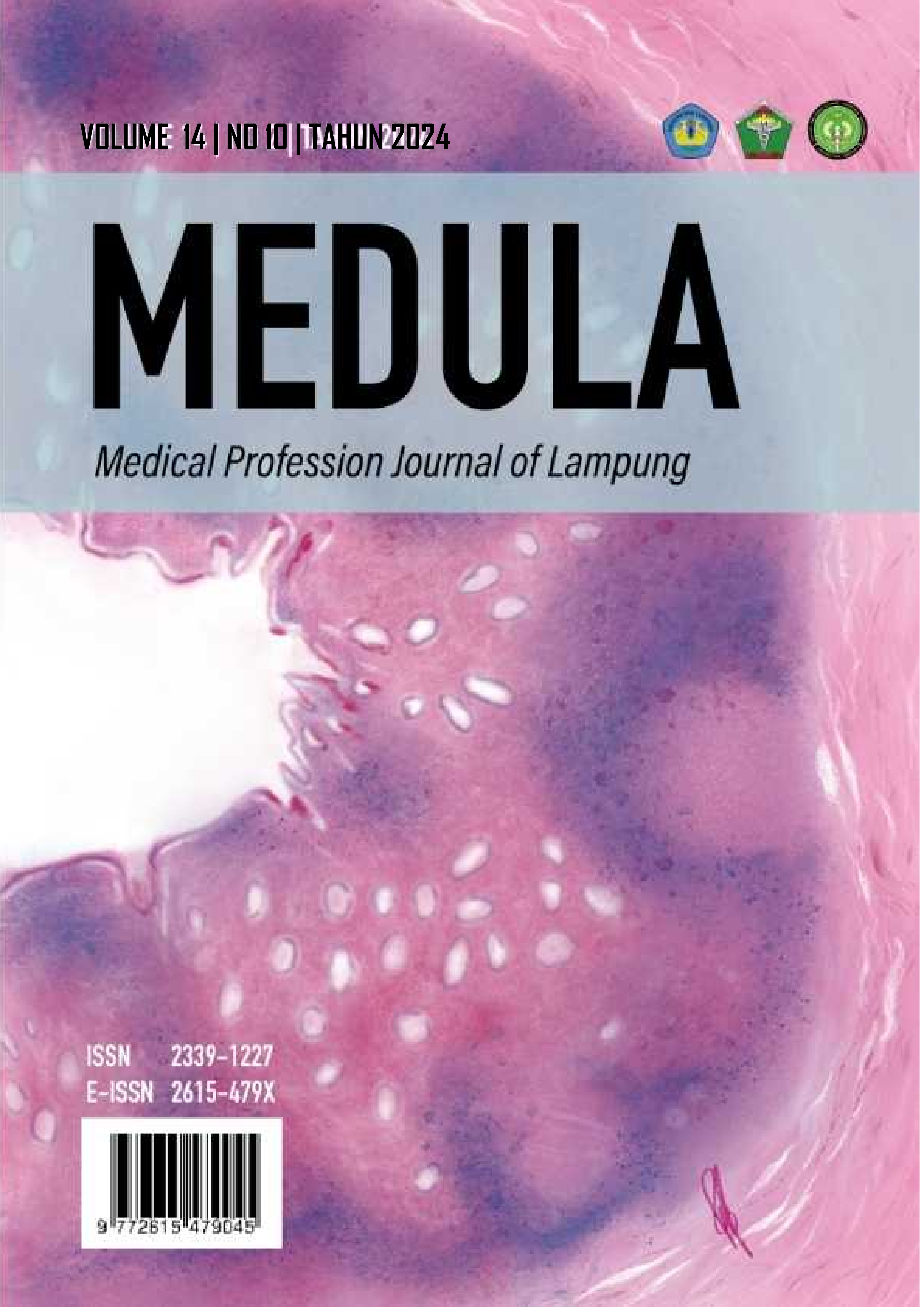Epley and Brandt-Daroff Maneuvers in the Management of Benign Paroxysmal Positional Vertigo (BPPV)
DOI:
https://doi.org/10.53089/medula.v14i10.1383Keywords:
Benign Paroxysmal Positional Vertigo, Epley Manuever, Brandt-Daroff Manuever, VertigoAbstract
Benign Paroxysmal Positional Vertigo (BPPV) is the most common cause of vertigo with a case prevalence of 1.6% globally. It is characterized by recurrent episodes of vertigo due to changes in head position. BPPV disease is caused by the transfer of otoconia to the semicircular canal, stimulating the vestibulocochlear nerve resulting in symptoms of vertigo, nystagmus, and becoming more sensitive to head movement. The impact is significant on the physical, psychological, and quality of life aspects of the patient. This literature review discusses the mechanism, effectiveness, and success rate of Epley and Brandt-Daroff maneuvers. Data were obtained from relevant literature with data sources coming from Pubmed, NCBI, and Google Scholar. The results of the literature review showed that the Epley maneuver has high effectiveness with a cure rate of up to 92% within one week and a significant reduction in sequelae, especially in the modified Epley maneuver. In addition, the Brandt-Daroff maneuver proved to be effective for self-treatment at home with gradual improvement of vertigo symptoms. Both methods have advantages, such as the flexibility of the Brandt-Daroff maneuver and quick results in the Epley maneuver, but have certain limitations in patients with comorbid conditions. The conclusion of this literature review shows that the Epley maneuver is the first choice in the treatment of BPPV due to its higher effectiveness, while the Brandt-Daroff maneuver can be used as an alternative.
References
Kim HJ, Park JH, Kim JS. Update on benign paroxysmal positional vertigo. J Neurol. 2021;268(5).
Stanton M, Freeman A. Vertigo. Treasure Island (FL). StatPearls Publishing. 2024.
Palmeri R, Kumar A. Benign Paroxysmal Positional Vertigo. Treasure Island. StatPearls Publishing. 2022.
Rhim G, Kim MJ. Vitamin D Supplementation and Recurrence of Benign Paroxysmal Positional Vertigo. Nutrients. 2024;16(5): 689.
Cole SR, Honaker JA. Benign paroxysmal positional vertigo: Effective diagnosis and treatment. Cleveland Clinic Journal of Medicine. 2022; 89(11):653-662.
Koç A. Benign Paroxysmal Positional Vertigo: Is It Really an Otolith Disease?. Journal of International Advanced Otology. 2022;18(1):62-70.
Yetiser S. Review of the pathology underlying benign paroxysmal positional vertigo. Journal of International Medical Research. 2019; 48(4): 1-12.
Power L, Murray K, Szmulewicz DJ. Characteristics of assessment and treatment in Benign Paroxysmal Positional Vertigo (BPPV). J Vestib Res. 2020;30(1).
Chen X, Mao J, Ye H, Fan L, Tong Q, Zhang H, et al. The effectiveness of the modified Epley maneuver for the treatment of posterior semicircular canal benign paroxysmal positional vertigo. Front Neurol. 2023;14.
Strupp M, Mandala M, Vinck AS, Van Breda L, Salerni L, Gerb J, et al. The Semont-Plus Maneuver or the Epley Maneuver in Posterior Canal Benign Paroxysmal Positional Vertigo: A Randomized Clinical Study. JAMA Neurol. 2023;80(8).
Abdou Abd El-M El-Monem El-Deeb H, Ahmed Mohamed Eldesoky H, Mahmoud Elrefaey N. Effect of Epley’s Maneuver and Brandt-Daroff Exercises on Decreasing Severity and Recurrence of Benign Paroxysmal Positional Vertigo. Egyptian Journal of Health Care. 2023;14(1).
Gan Z, Zhou S, Yang H, He F, Wei D, Bai Y, et al. Self-Treatment of Posterior Canal Benign Paroxysmal Positional Vertigo: A Preliminary Study. Front Med (Lausanne). 2021;8.
Sharma N, Bali A, Anamika A, Sharma P. Effectiveness of Epley’s Maneuver in Posterior Canal Benign Paroxysmal Positional Vertigo: a Prospective Observational Study. Asian Journal of Pharmaceutical and Clinical Research. 2023; 16(5):89-93.
Khoujah D, Naples JG, Oliveira J. e Silva L, Edlow JA, Gerberi DJ, Carpenter CR, et al. Epley maneuver for benign paroxysmal positional vertigo: Evidence synthesis for guidelines for reasonable and appropriate care in the emergency department. Academic Emergency Medicine. 2023;30:501-516.
Laksono M, Kusumaningsih D. Efektivitas Penggunaan Latihan Brandt Daroff Pada Pasien Vertigo Dengan Masalah Keperawatan Gangguan Keseimbangan Di Desa Sumber Agung Kecamatan Sragi Lampung Selatan. Jurnal Kreativitas Pengabdian Kepada Masyarakat (PKM). 2022;5(7):2295–300.
Siagian M. Pengaruh Terapi Brandt Daroff Terhadap Tingkat Vertigo Pada Lansia Di Posyandu Lansia Bestari Maharani Pondok Benowo Indah Surabaya. Jurnal Keperawatan. 2022;11(2):45–51.
Choi SY, Cho JW, Choi JH, Oh EH, Choi KD. Effect of the Epley Maneuver and Brandt-Daroff Exercise on Benign Paroxysmal Positional Vertigo Involving the Posterior Semicircular Canal Cupulolithiasis: A Randomized Clinical Trial. Front Neurol. 2020;11.
Downloads
Published
How to Cite
Issue
Section
License
Copyright (c) 2025 Medical Profession Journal of Lampung

This work is licensed under a Creative Commons Attribution-ShareAlike 4.0 International License.














